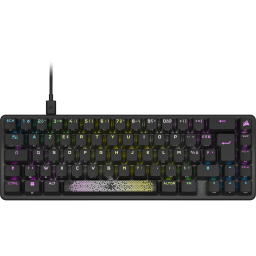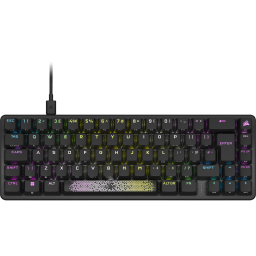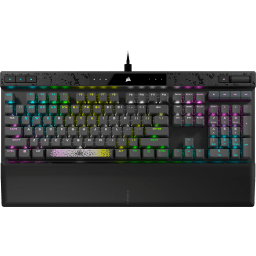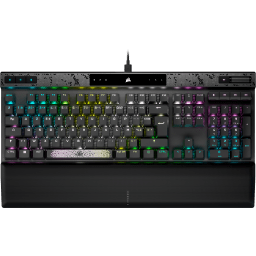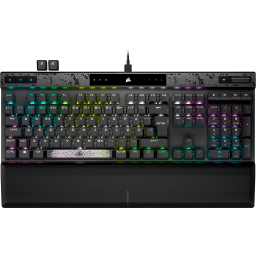I takt med at mekaniske tastatur er er vokset fra at være en niche-nørdehobby til at være en næsten uundværlig del af et pc-spil-setup, er udvalget af tastaturtyper også vokset. Det betyder, at der er flere mennesker end nogensinde, der prøver at komme ind i den mekaniske tastaturhobby, og da CORSAIR er en af de mest populære leverandører af mekaniske tastaturer, tænkte vi, at vi ville bruge et øjeblik på at opklare nogle ting.
Så lineær vs. taktil vs. klik - hvad er forskellen, og hvilken løsning skal du vælge?

For overskuelighedens skyld vil vi i dag ikke beskæftige os med, hvordan de forskellige typer af kontakter fungerer. De tekniske og ingeniørmæssige forskelle mellem optiske, magnetiske og traditionelle switche er et emne for en anden dag.
I stedet vil vi i dag tale om de tre vigtigste keyswitch-typer: Linear, Tactile og Clicky. Disse adjektiver henviser til kontakternes fysiske (og hørbare i tilfælde af Clicky) feedback. Da taktile og klikbare kontakter er afledt af lineære, starter vi der.
Lineære afbrydere
Lineære kontakter hedder sådan på grund af deres jævne og ensartede vandring. Den følelse, du får, når du trykker på en lineær kontakt, er den samme hele vejen ned gennem tastetrykket, indtil du når bunden. Den kraft, der skal til for at trykke på kontakten, forbliver uændret, og der er ingen andre funktioner som lyd eller det taktile bump, der kendetegner de to andre kontakter.

Eksempler på lineære kontakter er vores OPX-kontakter, MGX-kontakter og selvfølgelig den ærværdige og banebrydende Cherry MX Red. Hvis du ikke har nogen idé om, hvilken kontakt der sidder i dit mekaniske tastatur, er det sandsynligvis en lineær kontakt, da det er den mest populære kontakttype. Og selv om du bruger et membrantastatur i stedet for et mekanisk, kategoriseres membrankontakter som lineære, da de har den samme mangel på taktil eller hørbar feedback.
Når det gælder ideelle anvendelser for lineære kontakter, fungerer de godt til alt, og de kommer ikke i vejen for spil, arbejde eller almindelig computerbrug. Men problemet med at lave noget, der fungerer til alt, er, at det aldrig vil være perfekt til noget. Hvilket fører os til den næste type tast: Taktile.
Taktile kontakter
Taktile kontakter adskiller sig fra lineære kontakter ved, at der er et mærkbart "bump" i tastetrykket. Dette bump er mest almindeligt ved aktiveringspunktet, som typisk er omkring halvvejs nede, men det kan være hvor som helst. Den mest kendte taktile kontakt er Cherry MX Brown.
Bumpet opstår, fordi du når til et punkt under tastetrykket, som kræver en lille smule ekstra kraft at overvinde, og når du har overvundet det, er resten af tastetrykket normalt. Dette bump er med til at give en lille smule ekstra feedback. Mange mennesker, inklusive ham, der skriver denne artikel, synes, at bumpet er tilfredsstillende. Hvis bumpet er ved aktiveringspunktet, ved du desuden præcis, hvornår tastetrykket er registreret. De, der skriver meget, kan bruge dette til at træne sig selv i at holde op med at bumpe og få en langt mere skånsom skriveoplevelse.

Så har vi endelig fået noget fysisk feedback, men hvad med et hørbart signal? Her er vi nødt til at tale om Clicky switches, en kardinalsynd for kontoransatte, men ikke desto mindre et populært valg.
Klikbare kontakter
Clicky switches ligner funktionelt taktile switches med det samme bump halvvejs nede i tastetrykket. Men i modsætning til de taktile kontakter lyder der et klik, når du overkommer dette bump, og denne lyd adskiller sig fra den normale lyd fra en kontakt.
Det skyldes, at der sker noget fysisk inde i kontakten. Der er et stykke plastik inde i kontakten, som normalt er fastgjort til det krydsformede stykke, du kan se, når du fjerner keycaps. I clicky switches kan dette stykke bevæge sig, så når du overvinder det taktile bump, vi nævnte, slår det pludselig ned i bunden af huset. Det er det, der skaber det klik, du elsker eller hader så meget. Cherry MX Blue er den mest kendte variant af clicky switches.

Derudover kan de, der spiller mange multiplayerspil og ofte bruger Discord eller gode gamle TeamSpeak, finde sig selv som samfundets fjende nummer et. Desværre. Klikkene kan nogle gange snige sig forbi støjdæmpningen i gaming-headsets mikrofoner og dermed gøre dig til den mest irriterende person på serveren.
Det er interessant, at i takt med at populariteten af brugerdefinerede tastaturer er steget, synes klikafbrydere at falde i unåde. I dag er den typiske "mekaniske tastaturstøj" ikke den eneste foretrukne egenskab, og følelsen af kontakterne bliver mere og mere prioriteret.
En af måderne, folk forbedrer følelsen på, er ved at smøre kontakterne. Det skaber et problem, da smøring af klik-kontakter nok til at skabe den ønskede følelse vil påvirke lyden negativt, hvilket er hovedårsagen til at få en klik-kontakt i første omgang.
Okay, så nu har du fået en kort introduktion til de tre hovedtyper af mekaniske tastaturkontakter. Lad os nu sammenligne dem direkte, head to head to head.
Lineære vs. taktile vs. lineære nøglekontakter: En direkte sammenligning
Nu ved vi, hvordan hver enkelt switch er, men for virkelig at blive klogere har vi brug for kontekst. Her følger en tabel, så du kan se de vigtigste forskelle med et enkelt blik, og så forklarer vi lidt mere for at få lidt mere dybde.
Tabel Key:
- Følelse: Dette beskriver den fysiske fornemmelse af kontakten, når der trykkes på den
- Lyden: Der findes tusindvis af nøglekontakter, så dette refererer til den typiske lyd fra den pågældende kontakttype.
- Vægt: Dette er en grov beskrivelse af, hvor hårdt et typisk eksempel på en kontakt er at trykke på. (Der vil være nogle kontakter derude, som måske ikke følger denne konvention).
- Bedste anvendelse: Den ideelle brugssituation for kontakten.
- Pris: Switches varierer voldsomt i pris, men der er et typisk hierarki at forvente her.
| Lineær | Taktil | Klikker | |
| Mærk efter | Jævn og konsekvent fra start til slut. | Der er et bump på et eller andet tidspunkt under tastetrykket, typisk i toppen. | Der er et bump på et tidspunkt i løbet af tastetrykket, typisk midtvejs. |
| Lyd | Stille eller næsten stille. | Stille eller næsten stille. | Højt ved det bump, der skaber klikket. |
| Vægt | Lys. | Tyngre. | Den tungeste. |
| Bedste anvendelse | Spil. | Skrivning. | Skrivning, men kun hvis du er langt væk fra dine kolleger. |
| Pris | Billig. | Dyrere. | Den dyreste. |
Lineære vs. taktile nøglekontakter
Lineære og taktile kontakter er de mest populære typer, så for de fleste derude vil valget stå mellem disse to. Du skal tænke over, hvad du tror, du vil foretrække, og hvad du bruger dit tastatur til.
Lineære kontakter er normalt meget lette, dvs. nemme at trykke på. Det gør dem meget hurtige, hvilket igen gør dem til de bedste til gaming, da det effektivt reducerer din reaktionstid. De kan dog føles lidt "kedelige" på grund af den manglende feedback, indtil du rammer bunden og smadrer ind i tastaturets ramme.
Taktile kontakter kan til sammenligning føles meget bedre, når man skriver. Bumpet er en dejlig fornemmelse, og det opstår typisk ved aktiveringspunktet (dette er det punkt under tastetrykket, hvor computeren registrerer tastetrykket). Dette bump kræver i øvrigt en lille smule ekstra kraft at overvinde, hvilket betyder, at den samlede vandring ikke er konsekvent. Nogle synes, at det er irriterende, mens andre mener, at det er helt afgørende. Taktile kontakter er ikke så velegnede til gaming som lineære kontakter, men medmindre du spiller på absolut højeste niveau, vil dit valg af kontakt ikke have nogen målbar indvirkning på din præstation.
Taktile vs. klikbare nøglekontakter
Denne sammenligning er lidt mindre nuanceret. Hvor taktile og lineære kontakter har stort set identiske lydsignaturer, kan den klikkende nøglekontakt være meget højlydt.
Vi nævnte, hvordan den bevægelige slider skaber støj længere oppe på siden, men det er værd at nævne, at denne støj kan variere meget med hensyn til lydstyrke. Slideren smækker ned for at skabe støjen, når bumpet overvindes, men jo større bumpet er, jo hårdere vil slideren smække nedad.
Det betyder, at lyden kan være så subtil, at den næsten ikke kan skelnes fra den normale lyd, der opstår, når kontakten går i bund. I den anden ende kan den dog være høj. Virkelig høj. Højt nok til at skabe en vedvarende misforståelse om, at alle, der bruger mekaniske tastaturer, er ulidelige og uudholdelige at arbejde i nærheden af.
Så hvis lineære kontakter er ude af billedet, og du prøver at vælge mellem taktil og klik, skal du vide, at den fysiske fornemmelse stort set er identisk, så du skal egentlig bare tænke over, om du vil have kliklyden eller ej. Det er værd at gentage, at de, der ønsker at åbne deres kontakter for at smøre dem, skal være opmærksomme på, at det er langt sværere at smøre en klik-kontakt. Man skal være ekstremt forsigtig, ellers risikerer man at påvirke lyden.
Lineære vs. klikbare nøglekontakter
Linear og Clicky switches er lidt underlige at sammenligne, fordi de ligger længst væk fra hinanden i både følelse og lyd. Linear giver dig den mest diskrete oplevelse, da den er lydløs for ørerne og glat for fingerspidserne, mens clicky switches, som du nu ved, giver dig stor feedback i form af lyd og taktilitet.
Hvis du har været splittet mellem disse to, vil vi gentage, at du bør undgå clicky switches, hvis du arbejder tæt på andre. Og hvis du ofte bruger Discord eller endda OG Teamspeak til at spille med andre, bør du virkelig overveje lineære switches. Clickies kan ofte høres via din mikrofon og er ikke helt så hurtige, når det drejer sig om konkurrencespil. Realistisk set vil det ikke gøre den store forskel, men det er alligevel værd at bemærke.
Så hvilken kontakt skal du vælge?
I bund og grund er det op til dig. Medmindre du spiller på et virkelig konkurrencepræget niveau, så er lette, lineære kontakter helt sikkert vejen frem. For dem, der bare spiller normalt, blandet med arbejde og almindelig computerbrug, kan du vælge den kontakt, du foretrækker. Igen skal du dog være på vagt over for dem, der klikker, så du ikke bliver udelukket fra Discord-serveren.
Det er også værd at nævne her, at hvis du er usikker på, hvilken kontakt du vil kunne lide, eller måske vil prøve nogle uden at skulle købe et nyt tastatur, skal du købe et hot-swap-tastatur som CORSAIR K70 PRO MINI WIRELESS. Disse typer tastaturer giver dig mulighed for at skifte kontakter, når du vil.
PRODUKT REGISTRERING





